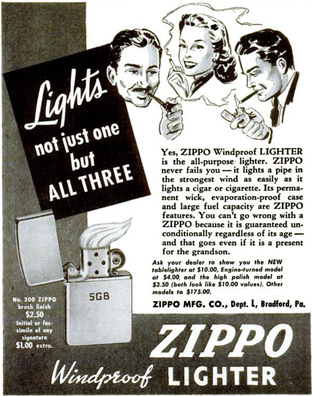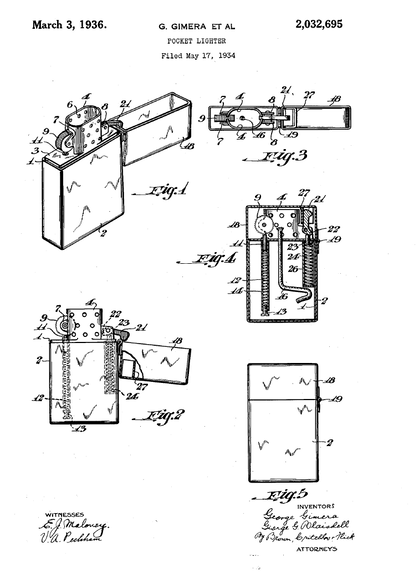 1947 Advertisement
1947 Advertisement
On March 3 of the year 1936, U.S. Patent No. 2,032,695 issued to George Gimera and George G. Blaisdell, both of Bradford, Pennsylvania, for a "Pocket Lighter", which is now universally recognized as the iconic Zippo® lighter. As the story goes, Blaisdell got the idea for the Zippo® lighter at the Bradford Country Club when he saw a friend using an Austrian made Imco lighter to light a cigarette. Blaisdell was impressed with the way the Imco lighter maintained its flame in the wind, but was not impressed with the way it looked or how it operated. The Imco lighter was rather ugly and awkward to use. When Blaisdell asked his friend why he didn't buy a decent-looking lighter, the friend replied: "Well George, it works".
The incident at the counry club inspired Blaisdell to obtain distribution rights for the Imco lighter in the U.S. However, that business deal fell through, most likely because Blaisdell had a hard time selling the Imco lighter due to its ungainliness. Undeterred, Blaisdell decided to redesign the Imco lighter to be more appealing and enlisted the help of Gimera to do so.
Gimera and Blaisdell retained the perforated chimney of the Imco lighter, which enabled it to maintain its flame in the wind. The rest was radically changed. Most importantly, they redesigned the overall structure of the lighter to have a rounded rectangular shape that fit snugly in the palm of a human hand. A lid was attached to an outer case with a hinge and was biased toward both a fully open (horizontal) position and a fully closed (vertical) postion by a spring toggle lever. The outer case had an open top end and telescopically received an insert that had an open bottom end and carried the chimney. Together, the outer case and the insert formed a reservoir for holding lighter fluid. A rotatable flint wheel was attached to the chimney and engaged a spring-biased flint mounted to the insert. A wick was enclosed in the chimney and extended into the reservoir.
The lighter created by Gimera and Blaisdell was aesthetically pleasing and easy to use. Coupled with the catchy trademark "Zippo" created by Blaisdell as a derivative of "zipper", the lighter quickly became a commercial success. On May 17, 1934, Gimera and Blaisdell filed the application for the '695 patent. It took almost two years for the patent to grant and it contained only a single claim that was rather narrow, reciting the features of the outer case, the insert with the chimney and the spring toggle connection of the lid to the outer case.
The Zippo® lighter was heavily used by U.S. servicemen in World War II, which helped establish its reputation as being rugged and dependable. Numerous stories were spread about how the Zippo® lighter saved the lives of U.S. servicemen in the forests and skys of Europe and in the jungles of Asia. After World War II, the Zippo® lighter achieved cultural icon status by appearing in numerous Hollywood movies. Later, the Zippo® lighter morphed into a form of art when U.S. servicemen heavily personalized them during the Vietnam War.
The incident at the counry club inspired Blaisdell to obtain distribution rights for the Imco lighter in the U.S. However, that business deal fell through, most likely because Blaisdell had a hard time selling the Imco lighter due to its ungainliness. Undeterred, Blaisdell decided to redesign the Imco lighter to be more appealing and enlisted the help of Gimera to do so.
Gimera and Blaisdell retained the perforated chimney of the Imco lighter, which enabled it to maintain its flame in the wind. The rest was radically changed. Most importantly, they redesigned the overall structure of the lighter to have a rounded rectangular shape that fit snugly in the palm of a human hand. A lid was attached to an outer case with a hinge and was biased toward both a fully open (horizontal) position and a fully closed (vertical) postion by a spring toggle lever. The outer case had an open top end and telescopically received an insert that had an open bottom end and carried the chimney. Together, the outer case and the insert formed a reservoir for holding lighter fluid. A rotatable flint wheel was attached to the chimney and engaged a spring-biased flint mounted to the insert. A wick was enclosed in the chimney and extended into the reservoir.
The lighter created by Gimera and Blaisdell was aesthetically pleasing and easy to use. Coupled with the catchy trademark "Zippo" created by Blaisdell as a derivative of "zipper", the lighter quickly became a commercial success. On May 17, 1934, Gimera and Blaisdell filed the application for the '695 patent. It took almost two years for the patent to grant and it contained only a single claim that was rather narrow, reciting the features of the outer case, the insert with the chimney and the spring toggle connection of the lid to the outer case.
The Zippo® lighter was heavily used by U.S. servicemen in World War II, which helped establish its reputation as being rugged and dependable. Numerous stories were spread about how the Zippo® lighter saved the lives of U.S. servicemen in the forests and skys of Europe and in the jungles of Asia. After World War II, the Zippo® lighter achieved cultural icon status by appearing in numerous Hollywood movies. Later, the Zippo® lighter morphed into a form of art when U.S. servicemen heavily personalized them during the Vietnam War.


